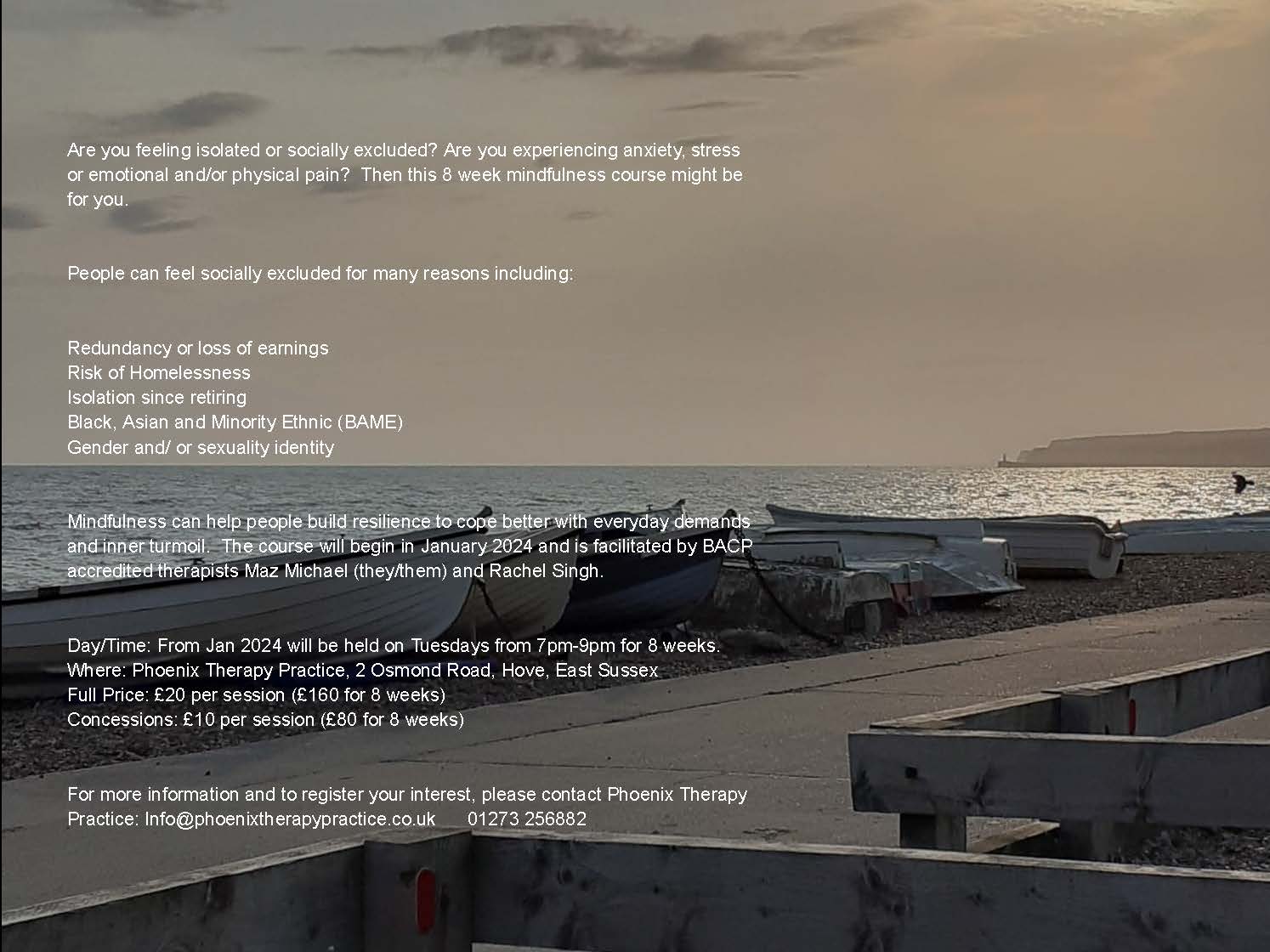Psychoanalytic and Psychodynamic Psychotherapy, Counselling, Person Centred Therapy, Gestalt therapy, Arts therapy, EMDR, Couples therapy, Therapy for children, Therapeutic Creative Writing, Integrative Therapy.
Our centre is now open. Our practitioners continue to offer counselling and therapy via video-link, phone or in person. Free initial consultations are also available. Careful, considered and contained therapeutic support can help people to develop lasting psychological change, a sense of emotional well being and a better quality of life, and can reduce mental health difficulties on an ongoing basis.
Our services include:
We offer both individual therapy and Groups.
Counselling and therapy can be helpful with a large number of different complaints including the following:
- Depression and low self esteem
- Anxiety and panic attacks
- Stress and trauma
- Gender issues
- Childhood Sexual Abuse
- Self harm
- Suicidal feelings
- Anger
- Relationship difficulties
- Domestic Violence
- Unresolved grief
- Phobias
- Eating disorders
- Early trauma
- Post traumatic stress disorder
- Health anxiety
- Relationship Issues
- Sexual difficulties
- Personality disorder
- Boarding School Syndrome
The aim of psychotherapy of whatever kind, is to help people to better manage and deal with their feelings, to cope with relationships as effectively as possible, to change their behaviour and to generally feel better. Talking is an important part of our relationships. Talking about what is bothering us and sharing our thoughts and feelings can help us clarify things, understand more about what is going on, and help us to explore how best to manage. Being listened to helps us to connect to others and feel valued by them.
There is a link between our childhood experiences, how we relate to ourselves, how we relate to those around us, how we feel and how effectively we are able to function. Different therapies address different aspects of these issues.
Psychoanalytic and Psychodynamic Therapies
This tends to aim to help the individual to explore the links between the past and the present. To help the person to understand what they feel and why they feel it, and to see how this relates to their early childhood experiences as well as the current situation. The idea is that if we understand and see why we do things we then have a choice about whether we do them. Very often a person’s relationship to themselves (low self esteem, self criticism, self destruction) is mirrored in the way that they relate to those around them. Also, if we are negative towards ourselves , it is very hard to let anyone get close to us, for fear that they see what we think we see. This can become a vicious circle.
Very often we are afraid of our feelings because we have been taught that they are wrong and destructive. In fact, the destructiveness most often occurs when we try to deny, hide or repress our feelings. Through the development of a close therapeutic relationship with the therapist or counsellor, psychodynamic work can help explore and express feelings and work through them so that the person comes to accept themselves for whom they are and work through what they have experienced.
Psychodynamic therapy is unstructured and tends to be open ended. Emotional difficulties and mental health problems often develop over a prolonged period of time. Deep and lasting change can take time too. This kind of therapy provides a long term, safe and secure relationship in which unresolved conflicts can be explored in more depths.
Integrative psychological therapy
This reflects the idea that different (evidence-based) therapeutic approaches are likely to benefit different people at different times, and that therapy models can be fruitfully integrated to meet the individual client’s needs and wishes. It is a flexible and inclusive way of working that is considered quite progressive by some. Different approaches may be used, one after another, throughout different stages of the therapeutic process; or they may be used as a single combined form of therapy throughout. For instance, CBT may be blended with Dialectical Behaviour Therapy (DBT) and elements of psychodynamic psychotherapy.
Integrative therapy can be longer-term or short term, and it is delivered within the context of a strong, deeply collaborative therapeutic relationship. Empathy, authenticity, compassion, active listening and respect are cornerstones of this practice.
Integrative therapy can be used with children, adolescents, and adults, in individual practice or group settings. The approach can be helpful for a variety of psychological difficulties, including depression, anxiety, borderline personality disorder, and panic disorder. You can always ask your therapist what models of therapy they integrate if you’re curious to know.
Eye Movement Desensitisation and Reprocessing (EMDR)
An empirically supported psychotherapeutic approach for treating trauma – either a single event trauma resulting in post- traumatic stress disorder (PTSD) or early relational trauma including emotional, physical or sexual abuse and neglect resulting in Complex PTSD. EMDR is not necessarily a short-term treatment, the length of the sessions required is largely determined by whether someone has experienced a single event trauma or longer term, more complex relational trauma. It is also applicable to a wide range of other experientially based clinical complaints such as phobias, anxiety disorders including Panic Disorder and Social Anxiety, Health Anxiety, Grief and Mourning, Depression and Addictions.
EMDR is guided by the Adaptive Information Processing Model (AIP), which conceptualises the effects of traumatic experiences in terms of dysfunctional memory networks in a physiologically based information processing system.
EMDR utilises the natural healing ability of your body. After a thorough assessment you will be asked questions about a particularly disturbing memory. Eye movements similar to those during REM sleep will be recreated by asking you to watch the therapist’s finger moving backwards and forwards across your visual field. Other forms of bilateral stimulation can be used such as auditory or tactile stimulation directing attention alternately to either side of the body and, by inference, to each cerebral hemisphere. Experiences during a session may include changes in thoughts, images and feelings. With repeated sets of eye movements (bilateral stimulation) the memory tends to change in such a way that it loses its painful intensity becoming a neutral memory of a past event. Associated memories may heal at the same time. The linking of related memories can lead to improvement in many aspects of your life.
EMDR can stand alone or successfully be incorporated into the talking therapies.
Person Centred therapy
One of the Humanistic schools of therapy and it is derived from the idea of Existentialism. As the term ‘Person Centred’ or sometimes called ‘Client centred’ implies, this approach privileges the client as being the expert on their own experiencing. As such, it challenges the idea that the therapist is the expert on the client. Person Centred therapy is based on the premise that all people possess an innate tendency (known as the Actualising Tendency) to develop and express their potential and that it is the environment that we grow up in that will determine to what extent we will fulfil this potential.
The Person Centred therapist strives to create an optimal therapeutic environment in which the client can learn to let go of parts of themselves that do not serve them and to allow more and more of their authentic self to emerge. The optimal environment is comprised of three Core Conditions, namely, Unconditional Positive Regard (a non-judgemental stance from the therapist towards the client), Empathy (an attempt by the therapist to step inside the client’s frame of reference and to understand their world) and Congruence (whereby the therapist presents their authentic self to the client rather than becoming a ‘blank screen’). More information on Person Centred Therapy can be found below.
Couples and Family Therapy
Very often within the course of couple or family relationships, difficulties emerge that need addressing. The difficulties presented may relate to one or more of a whole host of different matters: communication, intimacy, past relationships, separation and divorce, step-families, having an affair; young children, adolescent children, children who have left home; in-laws and grand-parents; being a single parent; bereavements; cross-cultural challenges; disability; elderly dependants; adoption; infertility; sexual problems; religion; financial, work, housing and unemployment problems; mental and physical illness; alcohol and drug misuse; past sexual abuse; domestic violence (physical, sexual, verbal, emotional or financial).
The difficulties people encounter can often be resolved without outside assistance, particularly if those concerned are able to communicate effectively with each other, listen to each other’s points of view and varying perspectives etc. Sometimes, however, it may be useful, even necessary, to discuss these difficulties by enlisting the help of an outside professional person, for example a relationship counsellor or family therapist, who is trained to help people explore the issues affecting them, understand themselves and each other better, relate better to each other, work things out for themselves and make decisions about what to do next. The number of sessions needed may range from one to several, depending on the nature of the difficulties.
Initial Couples and Family Consultations cost between £60-£80. They are not free.
Creative Arts Therapy for children and adults
This intentionally includes arts-based activities within the psychotherapeutic relationship. Like many talking therapies, arts therapy is psychodynamic, seeking to gain a closer understanding of ourselves and what underlies our difficulties, emotions and experiences.
When words are not easy to find, the arts can offer a form or ‘language’ for expression and communication, allowing new perspectives to emerge. Sand- tray, Improvisation, Working with metaphor, Puppets, Movement, Working with myths and stories, Art-making, and Role-play may be used alongside verbal communication, in varying degrees. For some, the emphasis may be more with verbal communication and choosing to use the arts minimally.
Arts therapy can help to increase our insight and understanding. It can help develop a stronger sense of self and grow self-confidence and esteem. Working through the arts provides a way of ‘externalising’ a problem, allowing you and your therapist to jointly explore it together. The ‘safe distance’ that the arts provide can help us to regulate feelings so that we can more readily explore matters at a pace which we can manage. In this way, arts therapy can also be a helpful treatment for trauma.
There is no need to have previous experience in drama or art. The arts are used intentionally for clinical interventions and to achieve clinical goals.
It can be a helpful therapy for children as well as adults and families.
For more information please see the following link:
Mindfulness
Although Mindfulness is not a type of therapy, it can be therapeutic. Whilst therapy typically is about looking at past traumas and/or current issues that are causing distress and working towards a new understanding, mindfulness is about noticing and observing current experiencing, moment by moment, so that neither the past nor the future distract us from what is here and now for us.
There have been numerous studies that indicate the efficacy of mindfulness and its beneficial impact, be that alleviating depression and anxiety or easing emotional and physical pain. Although meditation is one gateway to mindfulness, it is not the only way. We can learn to be mindful in our everyday lives whilst doing everyday activities such as eating reading a poem or even doing the dishes!
Contrary to common misconceptions, mindfulness meditation is not about zoning out, eliminating thoughts, nor is it necessarily about adhering to any particular faith or religion. It is a practice of tuning your attention to your mind and body and observing what is there. By noticing what is there, we then have the possibility of responding in a conscious way rather than habitually reacting to distressing inner or outer events.
Mindfulness draws from Cognitive Behavioural Therapy (CBT) techniques and thus teaches us to relate to thoughts and feelings in a more constructive and realistic manner. It can also involve breath awareness and mindful movement, it can involve noticing all of our senses and tuning in to our bodies, however, nothing is ever compulsory in a mindfulness session. Mindfulness classes simply present an invitation to experience moment by moment reality through a number of different routes. When we become mindful, we might notice that the only thing that is real and solid is the here and now, that life is made up of moments of the eternal present.
Discover Mindfulness with Phoenix Therapy Practice
Explore mindfulness through 1:1 sessions or sign up for our comprehensive 8-week in-person course with BACP Accredited therapists and Mindfulness Now (a British Psychological Society approved course) practitioners, Rachel Singh and Maz Michael (they/them).
Experience the power of mindfulness and unlock the potential to:
Gain deeper insight into your emotions and to learn how to respond rather than react to situations.
Enhance focus and concentration.
Improve relationships.
We invite you to start your mindfulness journey today and embrace a more mindful life.



